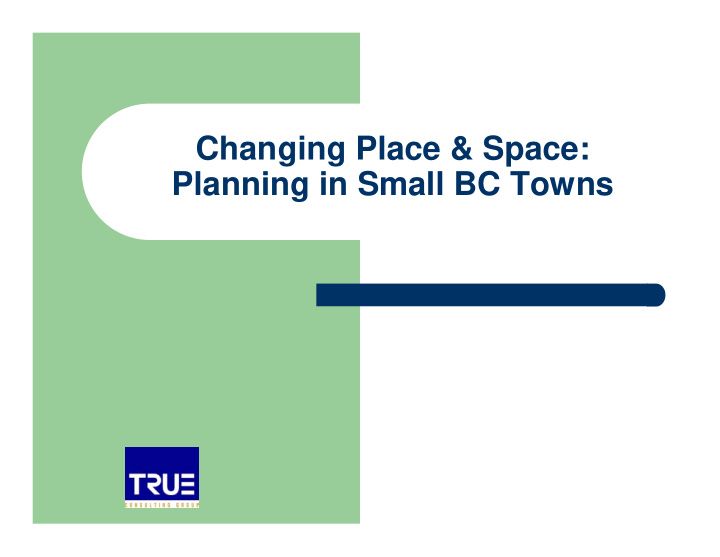



Changing Place & Space: Planning in Small BC Towns
� How well are current planning strategies working in small BC towns? � What are the challenges? � What are the successes? � What lessons can be learned? ������������������� ������������������� ���� ����
� Ortho � Picture of town
Houseboat Capital of Canada
Population Growth - Vancouver 700,000.00 600,000.00 500,000.00 Population 400,000.00 300,000.00 200,000.00 100,000.00 0.00 1961 1971 1981 1991 1996 2001 2006 2021 Year
Source: BC Stats ���� ���� ���� ���������� ���� 2676 persons ���� StasCan 2006 ���� ��� � � � � � � � � � � � � � � � � � � � � � � � � � � � � � � � � � � � � � � � � � � � � � � � � � � � � � � � � � � � � � � � � � ����
80+ 5% 4% Sicamous British Columbia 13% 6% 70-79 60-69 15% 9% 17% 15% 50-59 Age 40-49 16% 17% 30-39 8% 13% 20-29 7% 12% 10-19 11% 13% 0-9 8% 10% -20% -15% -10% -5% 0% 5% 10% 15% 20% 20% 15% 10% 5%
7000 ���� ���� 6000 ���� 5000 ���� 4000 Population ���� ���� 3000 ���� ���� 2000 1000 0 1991 1996 2001 2006 2011 2016 2021 2026 Year permanent residents (1.4%) seasonal & permanent residents (2.0%) seasonal & permanent residents (2.7%)
� Seasonal & resident projections @ 2.7% needs 1200 more lots/units � District has received applications for over 1300 more new units
Building Trends � 1996 – 2006 = 440 new residential units � In 10 years - 325 multifamily units - 115 single family units � @ 2.2 persons/per household = 1000 persons � Actual increase approx. 100 persons
3000 2886 -1%/yr 2740 -3.5%/yr 2671 -1.0% -3.5% +1.4% +1.4%/yr 2500 2357 2542 +0.9%/yr +0.9% Population 2324 2000 1500 1996 1998 2000 2002 2004 2006 2008 2010 2012 2014 2016 Year
Age 85 and over 1.7% 1.8% Lillooet BC 2006 Age 75-84 4.8% 5.1% 2006 Age 65-74 8.6% 7.6% Age 55-64 14.0% 12.3% Age 45-54 18.1% 16.1% Age Age 25-44 24.2% 27.4% Age 20-24 3.5% 6.5% Age 15-19 7.6% 6.7% Age 5-14 11.4% 11.6% Age 0-4 6.0% 4.9% 20% 20% 20% 10% 5% 5% 5% 5% 5% 10% 20% 20% 20%
Age 85 and over 1.7% 0.2% Lillooet First Nations Aboriginal On-Reserve 2006 Age 75-84 4.8% 2.0% 2004 Age 65-74 8.6% 4.4% 14.0% 6.9% Age 55-64 18.1% 13.4% Age 45-54 Age Age 25-44 24.2% 30.6% Age 20-24 3.5% 9.3% Age 15-19 7.6% 11.2% 11.4% 16.0% Age 5-14 Age 0-4 6.0% 5.9% 20% 10% 5% 10% 20% 30%
Housing & Population Statistics � 1124 private dwellings in 2006 � 986 dwellings occupied by the usual residents � 1241 private dwellings in 2001
Opportunities �������������������������� Existing Areas No. of Units � Vacant Lots 90 � Re-development & Intensification 20 � Multi-family 250 � Commercial/Multi-family Sites 150 � Redevelopment of properties with low (150) assessed values (<$25,000) 500 to 600
1. Protect wildlife habitat, green space and farm lands Successes: � Support Agricultural Land Reserve � Environmentally sensitive areas protected � Value open space
2. Build compact, mixed- use neighbourhoods Successes: � Vibrant Town Centre � Qualities of Town Centre embraced by community
Qualities of a Town Centre � attention to design � mix of uses � variety of tenures (rent, own) � diversity of people (lifestyles, ages, cultures, socio- economic class) � high development density � strong sense of place � pedestrian friendly � transportation node � maximizes potential for self-sufficiency (provides most things people need) � community involvement in planning, design, and management of the “main street” built form
3. Work within natural systems Strategies � Water sensitive land use planning � Green infrastructure � LEED design standards � Permeable surfaces Successes � Rural standards have fewer “engineered” “big pipe” solutions
4. Provide a variety of transportation choices Successes: � Interconnected streets � Cycling and walking routes � Compact town
5. Create diverse affordable housing options in Vancouver…. � 1971 – SFD/low density – 57% � 2001 – 41% � 2006 Census = 19.1% (SFD)
6. Connect jobs to homes � Successes: – Self employed – Compact development
� Housing Diversity Successes? – Lillooet 89% SFD – Sicamous 62% SFD � Housing Affordability success? – Lillooet maybe – Sicamous maybe
7. Embrace community identity Strategies � Public realm � Asset Mapping � Heritage buildings � Natural assets Successes: � countless
8. Engaged citizenship Strategies – Community design charrettes – OCP reviews – Civic and public spaces Successes: � Community facilities � & events
Recommend
More recommend